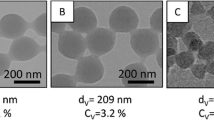Abstract
The effect of the silica nanoparticles on the morphology of a blend consisting of poly(methyl methacrylate) (PMMA) and the poly(styrene)-b-poly(butadiene)-b-poly(methyl methacrylate) (SBM) triblock copolymer was studied. Upon blending PMMA with SBM, macrophase separation between the block copolymer and homopolymer occurred, in which the higher molar mass chains of homopolymer separate into homopolymer-rich domains due to the ‘dry-brush’ regime, whereas the lower molar mass chains of homopolymer tend to be selectively solubilized in the block copolymer-rich domains due to the ‘wet-brush’ regime. Upon adding the hydrophilic silica nanoparticles to the PMMA/SBM blend, a significant suppression effect on the extent of macrophase separation between the homopolymer and block copolymer can be observed. It was shown that the silica particles are preferentially localized in the PMMA phase due to the strong hydrogen bonding interaction between the hydroxyl groups on the surface of silica nanoparticles with the carbonyl groups of the PMMA. The suppression effect of the silica particles may be related to the selective adsorption of the high molar mass PMMA on the surface of the silica particles, which may force the system into the ‘wet-brush’ regime, but this was only observed for the systems with a low silica content. For the systems with a high silica content, both the homopolymer PMMA and the PMMA block of the SBM block copolymer interact with the silica surface, which becomes the connecting part between both polymers, thereby suppressing the extent of macrophase separation.









Similar content being viewed by others
References
Bucknall CB (1977) Toughened plastics. Appl. Sci. Publishers Ltd., London
Meijer HEH, Govaert LE (2005) Mechanical performance of polymer systems: the relation between structure and properties. Progress Pol Sci 30:915–938
Jansen BJP, Rastogi S, Meijer HEH, Lemstra PJ (1999) Rubber-modified glassy amorphous polymers prepared via chemically induced phase separation. 3. Influence of the strain rate on the microscopic deformation mechanism. Macromolecules 32:6283–6289
Jansen BJP, Rastogi S, Meijer HEH, Lemstra PJ (2001) Rubber-modified glassy amorphous polymers prepared via chemically induced phase separation. 1. Morphology development and mechanical properties. Macromolecules 34:3998–4006
Jansen BJP, Rastogi S, Meijer HEH, Lemstra PJ (2001) Rubber-modified glassy amorphous polymers prepared via chemically induced phase separation. 2. Mode of microscopic deformation studied by in situ small-angle X-ray scattering during tensile deformation. Macromolecules 34:4007–4018
Van Casteren IA, Van Trier RAM, Goossens JGP, Meijer HEH, Lemstra PJ (2004) The influence of hydrogen bonding on the preparation and mechanical properties of PS-diblock copolymer blends. J Polym Sci Part B Polym Phys 42:2137–2160
Van Asselen OLJ, Van Casteren IA, Goossens JGP, Meijer HEH (2004) Deformation behavior of triblock copolymers based on polystyrene: an FT-IR spectroscopy study. Macromol Symp 205:85–94
Thomas EL (1999) The ABCs of self-assembly. Science 286:1307
Hardy CM, Bates FS, Kim MH, Wignall GD (2002) Model ABC triblock copolymers and blends near the order–disorder transition. Macromolecules 35:3189–3197
Ritzenthaler S, Court F, David L, Girard-Reydet E, Leibler L, Pascault JP (2002) ABC triblock copolymers/epoxy–diamine blends. 1. Keys to achieve nanostructured thermosets. Macromolecules 35:6245–6254
Brinkmann S, Stadler R, Thomas EL (1998) New structural motif in hexagonally ordered cylindrical ternary (ABC) block copolymer microdomains. Macromolecules 31:6566–6572
Krappe U, Stadler R, Voigt-Martin I (1995) Chiral assembly in amorphous ABC triblock copolymers. formation of a helical morphology in polystyrene-block-polybutadiene-block-poly(methyl methacrylate) Block copolymers. Macromolecules 28:4558–4561
Hydro RM, Pearson RA (2007) Epoxies toughened with triblock copolymers. J Polym Sci Part B Polym Phys 45:1470–1481
Fine T, Pascault J-P (2006) Structured thermoplastic/thermoset blends using block copolymers. Macromol Symp 245:375–385
Fenouillot F, Cassagnau P, Majeste JC (2009) Uneven distribution of nanoparticles in immiscible fluids: morphology development in polymer blends. Polymer 50:1333–1350
Li W, l’Abee RMA, Goossens JGP (2013) The control of silica nanoparticles on the phase separation of poly(methyl methacrylate)/poly(styrene-co-acrylonitrile) blends. Macromol Chem Phys 214:2705–2715
Kim BJ, Chiu JJ, Yi GR, Pine DJ, Kramer EJ (2005) Nanoparticle-induced phase transitions in diblock-copolymer films. Adv Mater 17:2618–2622
Kim BJ, Fredrickson GH, Hawker CJ, Kramer EJ (2007) Nanoparticle surfactants as a route to bicontinuous block copolymer morphologies. Langmuir 23:7804–7809
Kim BJ, Fredrickson GH, Bang J, Hawker CJ, Kramer EJ (2009) Tailoring Core–shell polymer-coated nanoparticles as block copolymer surfactants. Macromolecules 42:6193–6201
Balazs AC, Emrick T, Russell TP (2006) Nanoparticle polymer composites: where two small worlds meet. Science 314:1107–1110
Thompson R, Ginzburg V, Matsen M, Balazs AC (2001) Predicting the mesophases of copolymer-nanoparticle composites. Science 292:2469–2472
Lee JY, Thompson R, Jasnow D, Balazs AC (2002) Entropically driven formation of hierarchically ordered nanocomposites. Phys Rev Lett 89:155503
Kim JU, O’Shaughnessy B (2006) Nanoinclusions in dry polymer brushes. Macromolecules 39:413–425
L’Abee R, Li W, Goossens H, Van Duin M (2008) Application of FTIR microscopy in combinatorial experimentation on polymer blends. Macromol Symp 265:281–289
Huang Y, Jiang S, Li G, Chen D (2005) Effect of fillers on the phase stability of binary polymer blends: a dynamic shear rheology study. Acta Mater 53:5117–5124
Acknowledgments
This research is supported under project 07057 by the Dutch Technology Foundation STW, which is part of the Netherlands Organisation for Scientific Research (NWO), and which is partly funded by the Ministry of Economic Affairs. And the authors wish to thank Shanghai Young Teachers’ Training-funded Projects (ZZGJD13018); start-up project funding (Grant 0501-13-018).
Author information
Authors and Affiliations
Corresponding author
Rights and permissions
About this article
Cite this article
Li, W., Goossens, J.G.P. Morphology control of PS-b-PB-b-PMMA/PMMA blends by silica nanoparticles. Polym. Bull. 72, 1025–1037 (2015). https://doi.org/10.1007/s00289-015-1320-9
Received:
Revised:
Accepted:
Published:
Issue Date:
DOI: https://doi.org/10.1007/s00289-015-1320-9




